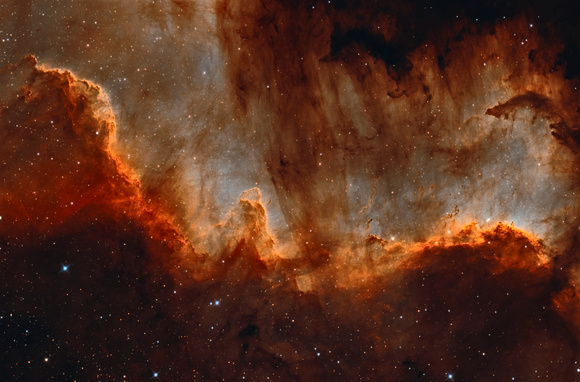The Cygnus Wall Nebula in Narrowband (modified Foraxx) w RGB stars (Cygnus) - May30 to June3, 2023
Planewave CDK12.5 - AIS6200MM
A-P Mach2 GTO, Antlia V pro 3nm NB filters
H,O,S: (20,17,13 x 600s exposures, Bin 2x2, Gain 200)
R,G,B: (11,11,9 x 180s exposures, Bin 2x2, Gain 100)
Total Integration Time = 9.9 hours
The Cygnus Wall is part of The North America Nebula (NGC7000), which together with the Pelican Nebula form a large star forming region.
Once a star reaches its age of majority and fusion begins, it no longer accepts material from the molecular cloud that created it. Instead, it sends out solar winds and radiation that pushes the molecular cloud away. The momentum from the stellar outflow can bulldoze the cloud away in a bank, as is the example of the Cygnus Wall. UV radiation also has the effect of creating ionization and lighting up the cloud in visible light - at least the parts that face the UV source. The uneven nature of the wall is a result of differences in cloud density and composition, which can cause fingering, columns, and bypassed tadpoles - all of which can result in additional star formation in the portions shielded from the stars energy. The parts of the cloud behind the wall are shielded and are much darker.
Of course, while this image is 2-D, this process takes place in 3-D, and there is a very large cloud between us and the wall, and this partially obscures the view. This dark area is actually part of a large cloud that actually separates the North America and Pelican Nebula.
Various suggestions have been made as to the star responsible for creating the wall as well as lighting up NA and Pelican - the current favourite is supposedly 56Cyg, which is a bright, hot star in the middle of the Pelican Nebula. However, the Cygnus wall is at a bit of an angle to this star and I think it is more likely that there are multiple stars that lights up these nebulae, one or more of which might be obscured by the dark molecular cloud.
To create this image, I used a modified version of the Foraxx palette, as presented in a
Pixinsight script by Paul Hancock. The script looks good, but instead, I used my own dynamic blending ideas with Pixlemath. The RGB data was used for the stars only.


